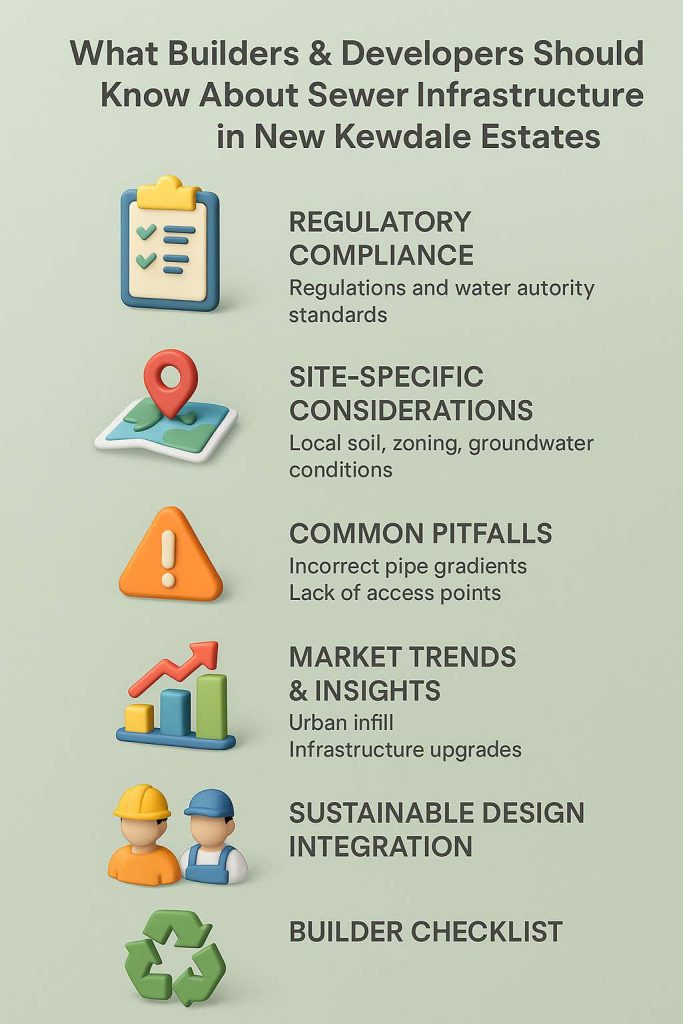New residential and commercial developments in Kewdale require careful planning for sewer drainage systems. Proper infrastructure is essential not only for functionality but also for compliance with local water authority standards. Developers must understand key aspects such as system sizing, regulatory approvals, environmental constraints, and future scalability.
1. Regulatory Compliance for Estate Sewer Systems
All sewer installations in Kewdale must comply with Water Corporation standards, which dictate:
- Minimum gravity sewer sizes (usually DN150)
- Adequate gradient for flow efficiency
- Access via manholes or inspection points
- Clearances from structures and other services
Approval from the Water Corporation is mandatory before any sewer works commence.
2. Site-Specific Considerations in Kewdale
Kewdale presents unique challenges:
- Mixed-use zoning: Industrial, commercial, and residential blocks demand flexible sewer layouts.
- Soil type: Sandy soils may increase infiltration risks; developers must ensure proper sealing and backfill methods.
- Groundwater: High water tables may require elevated pipe bedding or submersible pumping systems in low-lying lots.
3. Common Pitfalls for Builders to Avoid
- Incorrect pipe gradients leading to flow stagnation
- Poor coordination with stormwater infrastructure, causing cross-contamination
- Lack of access points for future maintenance
- Non-compliance with sewer offset requirements from boundaries and footings
Early engagement with licensed professionals such as a Kewdale Drain Plumber ensures correct layouts and long-term functionality.
4. Market Trends & Statistical Insights
Urban Infill & Density
- Perth’s urban infill strategies have led to higher-density developments in areas like Kewdale. This places added demand on existing sewer infrastructure.
- Kewdale has seen a 14% increase in lot subdivision applications over the last 3 years, requiring extensive sewer network extensions.
Infrastructure Upgrade Trends
- Water Corporation’s infrastructure investment has grown steadily, with over $350 million allocated to sewerage upgrades across the Perth Metro in the past 5 years.
- In Kewdale, several trunk mains have been reinforced or redirected to accommodate increased development.
Futureproofing
Developments must consider capacity for growth. A sewer system that meets today’s demands may be under strain within 5–10 years if not designed with scalability in mind.

5. Responsibilities of Builders vs. Plumbers
- Builders must coordinate planning, liaise with Water Corporation, and ensure final site layouts support efficient drainage.
- Plumbers must install sewer lines to code, conduct pressure and flow testing, and submit compliance documentation.
6. Sustainable Design Integration
Modern estates are expected to incorporate environmentally sustainable sewer solutions:
- Greywater diversion systems
- Permeable paving reducing stormwater runoff
- Overflow safeguards during flood conditions
- Future readiness for recycled water integration
Such features not only meet growing environmental expectations but can also reduce council contributions and improve resale value.
7. Builder Checklist for Kewdale Sewer Planning
- ✔ Confirm service availability (sewer vs septic)
- ✔ Obtain “Dial Before You Dig” plans
- ✔ Design sewer connections in line with Water Corporation DS50 requirements
- ✔ Coordinate drainage design with engineers
- ✔ Engage a licensed Kewdale Drain Plumber early in the process
- ✔ Schedule inspections and ensure as-constructed drawings are lodged
Conclusion
With Perth’s growth extending into suburbs like Kewdale, sewer drainage is no longer a routine task—it’s a critical infrastructure decision. Developers who prioritise compliance, planning, and professional plumbing partnerships reduce costly reworks and support sustainable, scalable urban expansion.